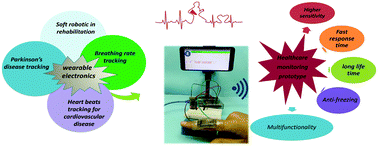A wirelessly multi stimuli-responsive ultra-sensitive and self-healable wearable strain sensor based on silver quantum dots of 3D organo-hydrogel nanocomposites†
Abstract
Novel multifunctional flexible strain sensors with enhanced properties have become an urgent requirement to comprehensively study the challenges of monitoring the full-range of human activities. Herein, we developed a stretchable strain sensor 3D nanocomposite of polydopamine/titanium dioxide/silver (PDA–TiO2@Ag) organo-hydrogel based on photopolymerization. During the synthesis of PDA–TiO2@Ag, Ag nanowires (NWs) decomposed into Ag quantum dots (QDs) in the presence of PDA–TiO2 nanocomposites without external irradiation or heating. This novel phenomenon implies the dominant photosensory role of the PDA–TiO2 nanocomposite in the decomposition of Ag NWs, suggesting that it possesses the ability of energy conversion. The developed sensor exhibits superior electronic and mechanical performance such as ultra-sensitivity (1993.17%) with a gauge factor (GF) of 9965.8 at a stress of 9.3 kPa and a strain of 600%, as well as a fast response time (6 ms), anti-freezing properties (−50 °C), self-adhesiveness, self-healing (3 s) and high stability with efficient and stable operation over more than 8750 cycles. We believe that the obtained results of the developed sensor might be relevant to its potential commercialization with mass production in wearable electronic devices for broad medical applications and the development of soft robotics and artificial intelligence devices.



 Please wait while we load your content...
Please wait while we load your content...